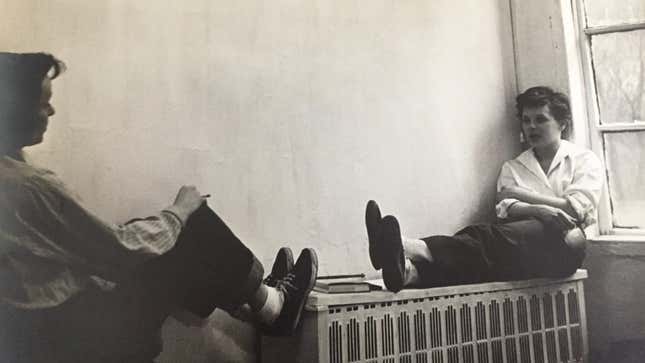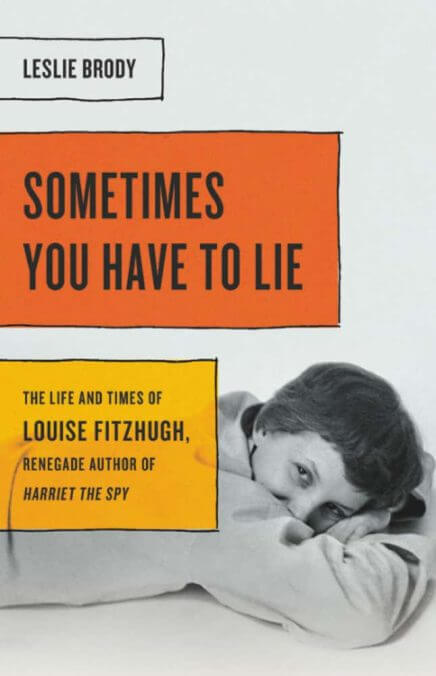How Harriet the Spy Found Its Home
In Depth
Image: Courtesy Sam Shea
It was Charlotte Zolotow, then a forty-eight-year-old senior editor in the Harper Books for Boys and Girls division, who first saw the earliest version of Harriet the Spy. In her department, any editor could open submissions that came in the mail, and if an editor found a manuscript she liked, and the higher-ups approved, that book was hers to edit. Charlotte knew that the literary agent Pat Schartle, who was a consummate professional, would only represent something of quality, so she wasn’t surprised that she found Louise’s pages delightful. She was, however, surprised by how brief the submission was: only around four typed pages, and most of it summary, with very little sample writing. What was there was a very funny introduction to an eleven-year-old and her notebook, in which she wrote brutally frank impressions of her neighbors on New York’s Upper East Side, where she lived with her sophisticated, affluent parents.
Charlotte had admired Louise’s illustrations for Suzuki Beane,
an Eloise satire about a beatnik child, and knew she was a painter, but since there were no illustrations included with the proposal, she presumed the book was for readers around the age of its heroine. Instead of asking for clarification, Charlotte took a leap. The note attached to the brief reader’s report she delivered to her boss, Ursula Nordstrom, read, “You have to get this writer to come in and talk. This isn’t a book, but it could be.”
In 1963, Ursula was the head of Harper Books for Boys and Girls, and she knew that her lieutenant, Charlotte, had a brilliant instinct for finding and drawing out great children’s books from new and incipient writers and illustrators. Charlotte also wrote successful picture books. Among these was the charming Mr. Rabbit and the Lovely Present, published in 1962, with illustrations by Maurice Sendak. Charlotte and Ursula agreed that Louise’s original story was sketchy and unfinished, but it did have an interesting heroine, and on that basis they invited her in to talk about the book she hoped to write.
“You have to get this writer to come in and talk. This isn’t a book, but it could be.”
On the day of their meeting, Louise arrived with another manuscript—this time an illustrated notebook, which Charlotte said contained no dialogue. Ursula and Charlotte loved the pictures, but they still were unsure whether Louise intended to write another picture book, like Suzuki Beane, or something for older children. Louise didn’t seem to know either. As the two editors read the short synopsis out loud, guffawing at their favorite lines, they made it clear they were enthusiastic about its possibilities but couldn’t yet see the book-to-be.
Louise, who never liked having her work scrutinized, sat slumped in a chair, arms crossed defensively. Charlotte thought she looked like somebody spoiling for a fight. (In later years she would say of Louise, “She was resentful of almost every adult she ever came across.”) At last, Louise spoke up: “So you’re not really interested, are you?”
Ursula assured her they were very interested, but they still had lots of questions. Charlotte asked, “Why is Harriet so angry?” Louise wasn’t ready for that one, and it woke her up. Until then, and despite their reputations, neither woman had really impressed her. Still, she wasn’t ignorant of the fact that this was a rare opportunity, one not to be squandered. Louise shot back, “She’s angry because her nursemaid went away and deserted her. She never wrote and she never came back.”

From that point, Ursula and Charlotte subjected Louise to what Alixe called a harrowing barrage of follow-up questions: Was she angry because she had dearly loved her nursemaid and didn’t want to be left behind? Had Harriet felt rejection in the suddenness of her nursemaid’s departure? How did she feel about being left behind with her parents? Was she angry because she recognized that as a paid employee, her nursemaid had just been doing her job? Or was it all about her helplessness as a child—never being told the truth and being left in the dark when a beloved friend disappeared? Was Harriet angry at the nursemaid, or was she angry at the world?
Most importantly: “There is no nursemaid in the story that you’ve shown us,” Charlotte told Louise. “Put her in.”
Then, for about an hour more, Ursula and Charlotte asked questions about Harriet’s school friends, her relationship with her parents, and her diary.
“Why is she keeping a diary?” Ursula asked.
“Because she wants to be a writer,” Louise replied.
The editors told Louise to go home and finish writing her book. If her audience was ten-year-olds, the book needed to be at least twenty thousand words. They encouraged her to keep it as funny as it was starting out to be. Furthermore, there were no restrictions on its vocabulary. When Louise asked if she could say people are finks, Ursula didn’t object. She liked Louise and wanted to give her every encouragement. She also gave Louise a “small” but “decent” advance.
On the day she received a completed version of Harriet the Spy, Charlotte brought the manuscript home in the old canvas tote she used to carry manuscripts to and from work. She asked her eleven-year-old daughter, Ellen, to read it, and waited impatiently for her verdict. Ellen zipped through the book—and happily reported that she loved it.
It was a lucky break for Louise to work with Charlotte Zolotow and Ursula Nordstrom. In 1963, Ursula was one of the most influential book publishers of children’s literature. Louise had not begun Harriet the Spy with the idea of writing a long book, but Ursula and Charlotte guided her to writing one book divided into three sections that, at 298 pages, was longer than the novels then typical for middle-school children. But Ursula knew her readership, and she was confident that Harriet the Spy would find its audience.
Ursula was respected as a hands-on editor. She famously cultivated long, supportive relationships with her stable of authors and illustrators, including Margaret Wise Brown, who wrote Goodnight Moon; E. B. White, author of Charlotte’s Web; Laura Ingalls Wilder, of Little House on the Prairie fame; H. A. and Margaret Rey, creators of Curious George; and Marc Simont, Tomi Ungerer, and Garth Williams, among other great illustrators. Around the time Louise and Ursula met, Harper Books for Boys and Girls had swept the year’s highest awards for children’s literature, including the Caldecott for Maurice Sendak’s Where the Wild Things Are and the Newbery for Emily Neville’s It’s Like This, Cat.
Louise was revising very quickly to meet a spring deadline and came to rely on Ursula’s experience. They shared a dry sense of humor, a progressive political perspective, and a love of music and dance. Louise told Jimmy Merrill that in short order, Ursula had become someone she truly admired. This was saying a great deal for Louise, who had few heroes. She thought Ursula decent, truthful, and droll. Ursula recognized Louise’s talent and set out to develop a rapport between them, as writer and editor, that she hoped would result in a lasting professional relationship. This meant encouraging her to trust that Harper’s commitment was to all of Louise’s writing, not just her books for children. In one long afternoon meeting, Louise sat down with Ursula and talked through all the manuscripts Louise had been working on for the past decade. This material included fragments and some finished sections of short stories and novels for adults. In a follow-up letter, Ursula wrote, “We’ve gone over the fascinating material you left with us a week ago, and I sort of think you might consider taking the very best things out of the various little books, and perhaps making one book of it. It really should be done as an adult book and so would you consider getting some of the things together so we can present it to an adult editor, I mean an editor of adult books?”
In their meeting, Louise had told Ursula about a novel she’d begun calling Mimi. Ursula replied that she was intrigued by Louise’s description and urged her to send the manuscript for her to read. It’s a tantalizing exchange and might be a clue to one of the mysteries associated with Louise’s work. Louise had been making notes and sketching a book about her childhood friend and first love Amelia Brent since her death in 1956. She had written various bits and pieces for years, and had shown two chapters of an unfinished novel to her partner, Alixe. Alixe thought the material was “beautiful . . . and overwhelmingly sad.” It was a romance between two young women set in Memphis. The age of the characters notwithstanding, Alixe understood this to be an adult novel. Louise often changed her titles. Was Mimi the working title of her Amelia novel?
Louise had also sent a chapter of her Amelia book-in-progress to her agent Pat Schartle, whose reply was disappointing. According to Alixe, Pat was “quite terrified . . . horrified because it was about lesbians.” Pat herself was bisexual, so it wasn’t the lesbians who terrified and horrified her, but perhaps she was frightened of the possible damaging effects such a book might have on Louise’s reputation as a writer for children. Alixe considered this episode a tragedy for Louise, saying, “She could’ve been a very successful [adult] novelist, and wasn’t, because Pat Schartle was fearful of its subject matter.”
It isn’t apparent that Louise shared Alixe’s view. Louise didn’t care for criticism, and she didn’t much like being told what she could or couldn’t do, but she didn’t fire Schartle as she had her previous agent, Gloria Safire. Neither Sandra Scoppettone nor M.J. Meaker, two writers with whom Louise was most likely to discuss her work, heard her mention a book-in-progress about Amelia. They were also unaware that Pat Schartle had refused to represent the book because it was a coming-of-age lesbian love story. Pat was a pragmatist. It is very possible that it was not the subject matter that dissuaded her. Two chapters are hardly enough to tell what a book will become, or, from an agent’s point of view, how to sell it. Louise had written one picture book for children, and Harriet the Spy was still months away from publication. Pat might have deliberately discouraged Louise from switching gears until she had built a dependable readership. She also might have asked Louise to show her more of the book when she had a more complete manuscript.
According to Alixe, Louise’s reaction was to put the manuscript away, perhaps intending to return to it at another time. In her subsequent letters to Louise, Ursula asked if she had made any progress on Mimi, but Louise didn’t reply to the query. She apparently never sent Ursula any pages from that novel or anything else about Amelia. No book called Mimi was ever published, and it didn’t show up in the inventory of unfinished works made after Louise’s death.
Excerpted from Sometimes You Have to Lie: The Life and Times of Louise Fitzhugh, Renegade Author of Harriet the Spy by Leslie Brody. Copyright © 2020. Available from Seal Press, an imprint of Hachette Book Group, Inc.